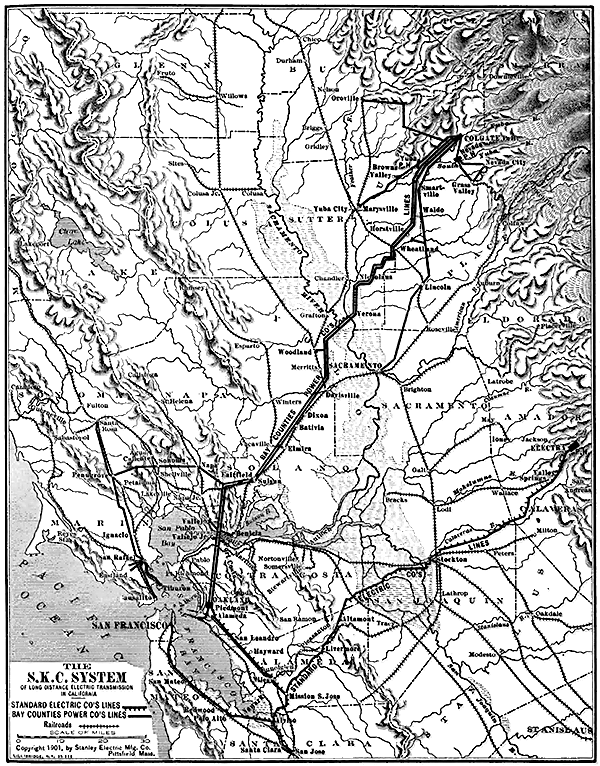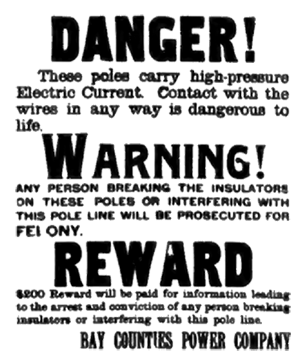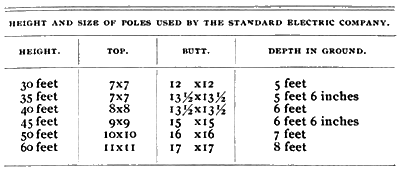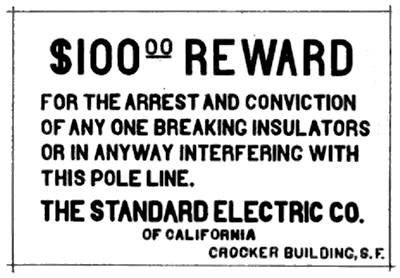[Trade Journal]
Publication: The Journal of Electricity, Power and Gas
San Francisco, CA, United States
vol. 12, no. 3, p. 53-55, col. 1-2
 |
An Extraordinary Pole Line System
WHILE complete descriptions of the pole line systems of the Standard Electric Company and the Bay Counties Power Company have been published in these columns hereto fore,* it is still a very instructive object lesson to have presented on a single page a composite map showing the extraordinary pole line system which has resulted from the temporary exigencies that have caused these two record breaking systems to be joined together into a single one of mastodonic proportions. At present the much talked of transmission is, therefore, a combination of these two systems, and it extends from the Colgate powerhouse, on the Yuba River, in Yuba County, clear through to Stockton by way of Oakland and Mission San Jose.
Through the courtesy of the Stanley Electric Manufacturing Company there is published on the preceding page an excellent map of these two great systems, and the pole lines thereon are entirely finished and ready for operation, while all of them are in actual commercial service twenty-four hours daily, except the stretch of forty-six miles from Stockton to the Standard Company’s power house at Electra, and the line from Redwood City to San Francisco, a distance of thirty-two and one-half miles. During the coming month the San Francisco substation of the Standard Company will be finished and power will be transmitted into San Francisco from Colgate, 212 miles distant, while the early completion of the Standard power house at Electra will cause the line between Stockton and Electra to be put into service.
The distances covered by these pole lines are as follows:
From Electra to Stockton, 46 miles. One circuit, 471,034 c. m., aluminum cable.
From Stockton to Mission San Jose, 49.6 miles. 471,034 c. m., special aluminum cable.
From Mission San Jose to Oakland, 26.3 miles. One circuit, 188,230 c. m., special aluminum cable.
From Alviso to San Jose, 8-1/2 miles. No. 1 B. & S. gage aluminum solid.
From Mission San Jose to Alviso, 9-1/2 miles. One circuit, 352,300 c. m., aluminum cable.
From Mission San Jose to Redwood City, 16.3 miles. One circuit, 352,300 c. m., aluminum cable.
From Redwood City to San Francisco, 32-1/2 miles. One circuit, 352, 300 c. m., aluminum cable.
From Electra to Oakland, 122 miles. One circuit, 352,300 c. m., aluminum cable.
From Electra to San Jose, 113.6. One circuit, 352, 300 c. m., aluminum cable.
From Electra to San Francisco, 153.9 miles.
From Colgate to Oroville, 28 miles. One three-phase circuit of No. 4 aluminum cable.
From Colgate to Nevada County power house, 7 miles. Two three-phase circuits.
From Colgate to the old Yuba power house, 8 miles. Two three phase circuits of No. 4 aluminum cable.
From old Yuba power house to Marysville, 18-3/4, miles. Two three-phase circuits of No. 6 copper.
From Colgate to Sacramento, 61 miles. Two three-phase circuits of No. 4 aluminum cable.
From Colgate to Oakland, 132 miles. Two three-phase circuits. North circuit of No. 00 B. & S. gage copper; south circuit of No. 0000 B. & S. aluminum cable, Colgate to Suisun, and No. 00 B. & S. gage copper, Suisun to Oakland.
From Colgate to Cordelia, 107 miles.
From Cordelia to Penn Grove, 26 miles. One three-phase circuit of No. 4 B. & S. gage three-strand aluminum cable.
From Penn Grove to Sausalito, 32 miles. One three-phase circuit of No. 4 B. & S. gage three-strand aluminum cable.
From Penn Grove to Santa Rosa, 13 miles. One three-phase circuit of No. 4 B. & S. gage three-strand aluminum cable.
From Colgate to Sausalito, 165 miles.
From Colgate to Stockton, 208 miles.
From Colgate to San Francisco, 211-3/4 miles.
 |
| This Notice is Tacked on All Bay Counties Poles. |
As to the poles themselves, those used on the Bay Counties’ lines are uniformly of the round cedar variety throughout the whole system. They were selected with great care from the best timbered sections of the Columbia River and its tributaries, whence comes the best of round cedar poles probably to be found in America. These poles are known as the round red cedar of Oregon, and are especially noted for their strength and lasting qualities in the ground, being far superior to any other kind of cedar on the Pacific Coast. This cedar has an average life of about thirty years for ground work, and is fast becoming popular with many large power plants. Great care is taken in the selection of them, in order that nothing but live trees should be used, and they were cut and trimmed during the fall and winter months, which is the best time. These poles are generally left in the woods for months after being cut, and, after being properly barked when green and thoroughly dried, are floated down the stream during the freshets of the spring to some convenient point of shipment, which is done either by vessel or by rail. To some who are not fully posted in the appearance of round cedar, it may be a surprise to know that often the roughest, toughest and most unattractive appearing poles are the ones that will last the longest in the ground, and which are, consequently, the most desirable. The unattractive appearance is frequently caused by “winter barking,’’ which is much more apparent in the fall and winter months, when the sap is out of the trees, than it is during the spring and summer, in consequence of which an inner bark is frequently left around the wood. This gives the pole a rough and unattractive appearance, but it can always be easily removed by the free use of the draw-knife; in fact the use of the draw knife should never be spared on any pole, as it is needed for appearance as well as for strength.
In the shipment of round cedar poles great care is taken in their inspection, and nothing is shipped but that which is first-class in every particular. The firm of Lindsley Bros. Company, of Portland, Or., are the largest dealers in this class of Oregon red cedar poler, and the major portion of the poles used on the Bay Counties’ system was supplied by them. The members of this firm are experienced pole men, and allow nothing to leave their yards which has not passed three inspections, namely, inspection of the poles as they are taken from the woods at the point on the river, inspection at the yards upon delivery, and for a third time when being loaded on cars for shipment. The California business of the Lindsley Bros. Company is now handled by Messrs. George E. Carter & Co., of San Francisco. The Bay Counties’ poles are in the following sizes:
 |
The features of the pole line system of the Standard Electric Company has been described so fully by Mr. C. O. Poole in his paper read before the San Jose convention of the Pacific Coast Electric Transmission Association, that little, if anything, further can be written in relation to it. The poles, which were furnished by the Union Lumber Company, of San Francisco, are all of the sawed redwood variety and were taken from the hearts of young trees. Not more than four poles were taken from any single tree, there being no sap whatever in the finished poles. The heights and sizes, together with the depths to which the poles are placed in the ground, are as follows:
 |
It should be added that in addition to the lines shown on the map, the Standard Electric Company is operating a three-phase line extending along the mother lode from Angels, in Calaveras County, to Amador City, four miles above Jackson, in Amador County. This line, which constitutes the old Blue Lakes circuit, is at present being operated from the old Blue Lakes power house, and consists of a three-phase circuit of No. 3 B. &S. gage copper wire, the Calaveras circuit, ex tending from the power house to Angels by way of San Andreas being thirty-one miles long, while the Amador circuit, which takes in Jackson, Sutter Creek and Amador City, with the scores of neigh boring mines, is about fifteen miles in length. Further extensions are being made by the Standard Electric Company in southerly and southwesterly directions from San Jose, and through the Suburban Electric Light Company of Oakland, Cal., secondary distribution at 4000 volts is being made through all the thickly settled fruit growing and suburban residence districts from Fruit vale (a suburb of Oakland) down to Alvarado and Newark, including San Leandro, Haywards, Sunol, Niles, Mission San Jose and Alviso. Indeed, the business of the Suburban Electric Light Company promises to become of the best properties in the way of the smaller electric power distribution companies in the State.
 |
| And This on All Standard Electric Company’S Poles. |
Referring to the Bay Counties’ system, the line for the transmission of electric service into Napa, Sonoma and Marin Counties leaves the main line to Oakland at Cordelia (not noted by name on the map). The steam plants at Santa Rosa, San Rafael and Sausalito have been shut down permanently, while that at Petaluma will probably be enlarged and continued in service as an auxiliary. In addition, a great gas plant is being built at Petaluma, and as soon as it is finished gas service will be delivered to Santa Rosa, San Rafael, Sausalito, San Quentin and intermediate localities from the Petaluma station by means of high pressure gas distribution. Further than this, the North Pacific Coast Rail road system, operating a narrow gage steam line from Sausalito through the redwoods along the coast to Cazadero, has been absorbed by the owners of the Bay Counties’ system, and the work of converting the local suburban steam railway service between Sausalito and San Rafael into a modern suburban electric railway system has already begun. This will throw a very heavy load on to the Colgate power house at the very end of a transmission line 165 miles in length.
In the meantime the engineering department of the Bay Counties’ system is reaching out for more power, and its first efforts in the way of further development will be at Cherokee and at French Creek, in Butte County. These new sources of power will come from the country contiguous to the Big Bend region of the Feather River, so famous in mining circles in California, and the new power house will be tied in directly with Colgate, which will necessitate in all some eighty miles of additional pole lines. The preliminary work for the new installation is well under way, and the management of the system is confident that an additional 8000-horsepower in electric energy will be delivered to the Bay Counties’ lines at Colgate before the heavy load of the coming winter shall be thrown upon the system.
In view of these extensions, absorptions and developments it is well to realize that another map will be in order for publication within a year, and that when it does appear the two great systems now described will have become regarded as being but the neucleii of a monster transmission network that, tentacular like, shall cover practically the whole of northern and central California.
